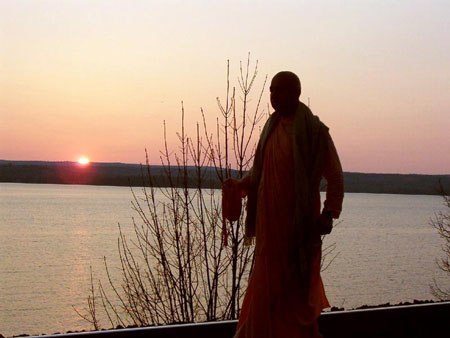Bhaktimarga Swami Reflects On Trans-Canada Trek
By His Holiness Bhaktimarga Swami | Сен 30, 2007

From the shimmering Pacific Ocean off the west coast of Vancouver Island in British Columbia to the lighthouse at Cape Spear, Newfoundland, overlooking the gray waters of the Atlantic Ocean, by God’s grace I have been able to complete a third walk across Canada, my native country, one of the largest land masses on earth. I covered more than 4000 miles, which with the similar pilgrimages of 1996 and 2003 brings the total distance covered to 12,400 miles (20,000km).
Figures might be important, but more relevant are the people I encountered. Whether I was traversing the Rockies, enduring the heat of the prairies, or savoring the breezes wafting from the Great Lakes, the response from the public was always phenomenal. It seems we are living in an age when people consider it a sign of good fortune if a monk visits their town. With motorists honking their horns and passersby wishing me well, there seems to be an envy of a free spirit.
The obsession with this form of power walking is that I find it an effective way to reach out and help raise spiritual awareness, while also gaining the parallel benefits of keeping fit. The personal communication that arises from such a venture is a tradition for monks (sannyasis) in the culture of Gaudiya Vaishnavism, a branch of mainstream Hinduism. As a student of A. C. Bhaktivedanta Swami Prabhupada, the founder of ISKCON, better known as the Hare Krishna movement, I became inspired about walking when I saw him on his morning walks discussing philosophy with his disciples.
Simply seeing a monk in their everyday lives, the townsfolk were naturally curious and would raise a variety of spiritual topics, while also donating food. The regional media would cover the occasion, with the result that practically every day thousands of people were hearing about the Hare Krishna monk and what he was doing in their area. This was an opportunity to let the public know that devotees of Krishna are not reclusive but are involved and socially concerned.
Of course, there were many days when human interaction was minimal, and when the elements and the wilderness were the raw reality. Much of the trip involved pitching a tent at night, and because the land is sparsely populated I was confronted with all kinds of wildlife and pests. However, the sight of bears, moose, elk, wolves and birds of many kinds compensated for the austerities. Also I was fortunate to have the companionship of Garuda Vahan, Daruka, and Jamuna Jivana (as well as a parrot named Billy), who shared in a support system that went a long way to ensuring the success of the journey.
If I have learned anything from these pilgrimages it could be encapsulated in one word – gratitude.
I now have my eyes on Europe as the next arena to bring spiritual life to the populace via the medium of walking. I firmly believe that if every human was to invest one hour of meditative walking into their day it would be a different world. There is certainly a vacuum in the life of the modern consumer. As an alternative, we could challenge the rat race by honoring the simple gesture of walking for spiritual healing.















